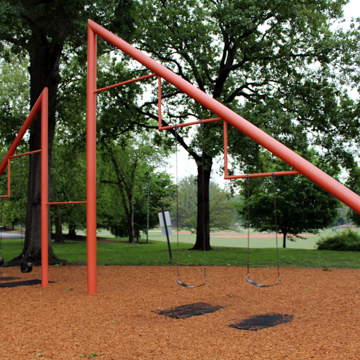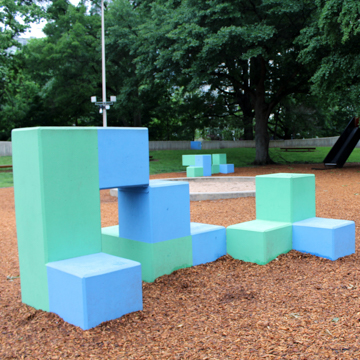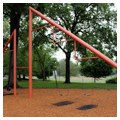Nestled in the wooded perimeter of Atlanta’s Piedmont Park, Isamu Noguchi’s Playscapes simultaneously serves as a playground and as public art. Playscapes is one of Noguchi’s only realized playgrounds, a bicentennial gift to the City of Atlanta from the High Museum of Art offered as part of the “Art in the Parks” initiative.
As a designer, Noguchi used sculpture to enrich the experience of public spaces. The sculptural forms of Noguchi’s play structures resonate within the Olmsted-designed landscape of Piedmont Park. Located within the heart of the vibrant Midtown neighborhood, Piedmont Park is a highly used public space, providing recreation for local residents and tourists alike. The city’s largest park is host to a multitude of festivals and events, and connects to Atlanta’s BeltLine, a multiuse trail still in development that encircles the city.
With the bold colors and the striking geometry of modern art, Playscapes provides an arena for imaginative and exploratory movement, rather than conforming to the standard-issue play equipment of the era. A cylindrical tower supports a royal blue spiraling slide that commands the roughly one-acre playground, complemented by the bright orange of an asymmetrical triangular swing set. Concrete cubes painted bright blue and green are artfully stacked within the site, providing imaginative climbing structures. The playground’s modernist aesthetics are emphasized with a strikingly angular metal slide construction, minimalist seesaws, and monkey bars sandwiched between distinctive geometries. A large circular sand pit, a low mound, and a sheltered pavilion provide further spaces for exploration.
Playscapes is the manifestation Noguchi’s decades-long effort to design a children’s landscape. His first attempt came in 1933, when he envisioned Play Mountain, a scheme that established the formal and spatial geometries that would reappear in future iterations of his playground designs. After a decades-long battle to build a playground in New York City, Noguchi finally saw his vision realized in Atlanta, where his design was met with enthusiasm and financial support, largely from the National Endowment for the Arts. The project was designed and built in less than a year, and featured many elements from Noguchi’s earlier playground plans.
After two decades of wear, the site was repainted in 1996 as part of Atlanta’s efforts to prepare the city for hosting the Summer Olympics. Despite this effort, the playground soon fell into disrepair. The structures aged and corroded in tandem with the heightening of illicit uses of the play equipment. For years, a chain-link fence surrounded the iconic slide structure to prevent drug activity within the cylindrical tower, and graffiti covered much of Noguchi’s meticulously crafted structures. The city funded a massive restoration project of the site, completed in 2009, repairing the play equipment’s structural issues and repainting the playground with its original colors. This project also reinstituted Noguchi’s intended layout for the playground, with minor revisions to improve safety conditions, such as the addition of lockable doors on the slide tower.
In 2014 there were further restoration efforts at the site, funded by Herman Miller Cares, with the goal of reinvigorating the playground as an iconic element of the city’s landscape. Playscapes was once again repainted, repaired, and re-mulched, to reassert the site as an innovative and culturally relevant landmark.
References
Danaparamita, Aria. “Playing with Art: The Isamu Noguchi Playscape.” Preservation Nation, September 19, 2013.
Kornblit, Bobbi. “IN Case You Were Wondering: Noguchi’s Playscapes.” Atlanta INtown Paper, 2005.
Lange, Alexandra. “The Great Playscapes.” WHY Magazine. Accessed April 14, 2017. www.hermanmiller.com.



























